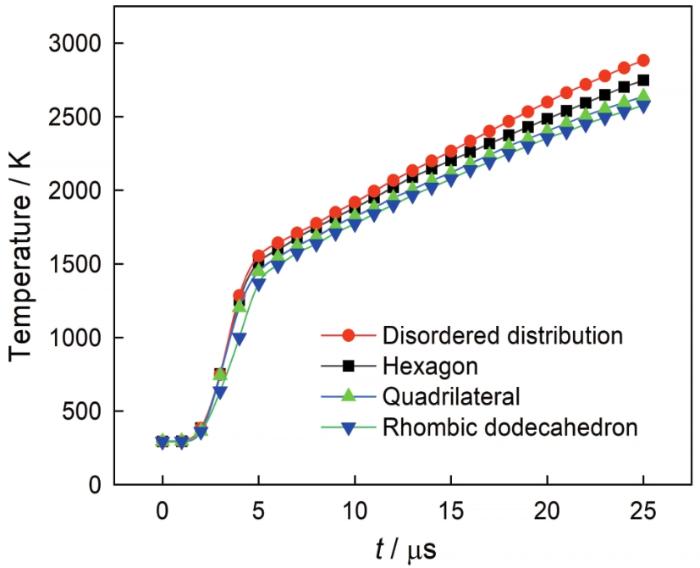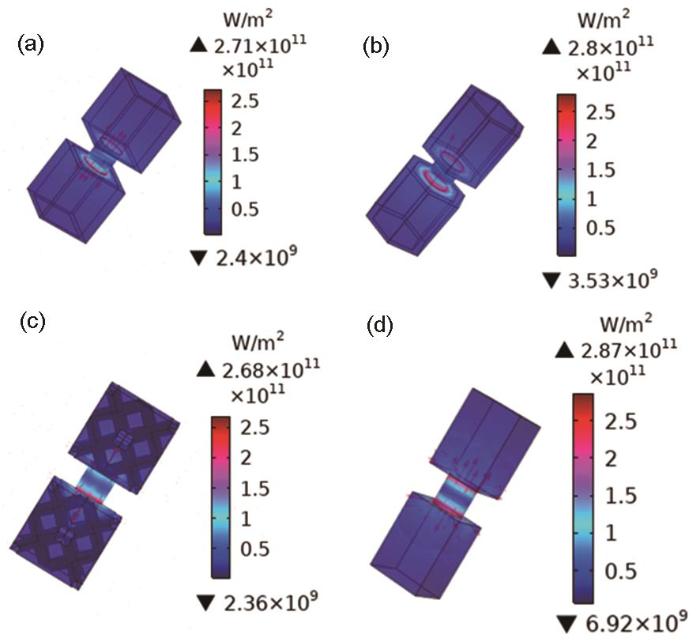电触头材料的熔焊故障,是开关设备触头接触失效的主要原因。熔焊分为静熔焊和动熔焊[1,2],静熔焊是接触电阻产生的焦耳热使触头材料熔化而发生粘连,动熔焊是电弧使触头材料蒸发喷溅和产生质量损失[3]。统计结果表明,熔焊失效占触头失效的60%以上[4]。提高电接触材料的抗熔焊性及导热、散热能力的工作,包括表面包覆、掺杂改性、纳米化增强相以及优化制造工艺。孙贤贤等[5]分别将铜纳米线和银颗粒加入石墨烯基体中,发现这两种纳米复合材料的致密度极高,石墨烯呈层状定向排列,两种三维石墨烯复合材料均具有较好的热稳定性。叶晨琳[6]用共沉淀法和水热法制备具有反尖晶石结构的立方体
近年来,受到大自然生物体微观结构启发,各国学者研究了有序微结构对复合材料导电和导热特性影响。张晓萌等[11]将高度取向结构引入到复合材料并使不同功能的填料在厚度方向上有序交替排布,从而使其导电性能和力学性能提高。为了制备导电高分子薄膜材料,王玉霜[12]在有序排列的亚微米PS微球表面电化学沉积一定量的导电聚苯胺,发现有序亚微米PS/PAN复合材料的导电性能和氧化还原性得到很大提高。宋品[13]用取向冷冻法构筑新型的有序结构三维组装体材料并调整参数和灌注聚合物弹性体,使其机械性能和导电性能提高。李双雯[14]利用聚合物与有序阵列的相互作用,控制其结构取向的有序性,制备多种一维定向有序复合材料,提高其力学、导电、导热性能。英俊峰等[15]开发设计了一种由高度结晶和水平排列的石墨烯片组成的互连和高度有序的石墨烯框架,嵌入环氧树脂使HOGF/EP复合材料的导热性能大幅提高,表明高度有序的微观排列结构对材料的结构设计有指导价值。卢舒欣[16]研究发现,具有有序孔结构的多孔陶瓷的有效热导率与孔隙率有关,且有序排列的孔结构可提高孔结构方向上的力学性能。也有设计仿生结构的提高材料的电、热、力综合性能。孙云娜等[17]为了提高复合材料的热性能提出类似于叶脉系统的网纹仿生结构,其热阻较小且对结构有支撑作用,使机械结构更加稳定。雷永鹏[18]基于丝瓜微结构的超轻仿生结构设计一种类似泡沫金属的新型多孔结构材料,发现具有比工程常用材料更高的强度和较低的有效导热系数,表明改变孔隙的排列分布可改变其导热系数。孙奉强[19]受蠕虫身体结构的启发制备了蠕虫状仿生结构石墨烯/聚氨酯导电纤维,发现该结构的石墨烯/聚氨酯导电膜成膜性逐渐变差,电导率逐渐提高,具有良好的弹性回复性和稳定性,耐久性能更加出色。
韩颖等[20]采用熔渗法制备了具有微观定向W片层骨架结构Cu-W复合材料,发现其在沿片层方向上呈现出更高的导电性能与压缩强度。本文研究微观W骨架结构对Cu-W复合材料静熔焊性能的影响。
1 计算模型
1.1 几何模型
蜻蜓翅膀中类似四边形网格的主脉和类似六边形网格的从脉起主要的承重作用,且翅脉的拟自相似特征具有良好的输运特性,如图1所示,这种拟自相似特征已经应用于设计电子元件微流道散热结构。受蜻蜓翅脉的启发,将其仿生结构用于设计触头微观结构。兼顾触头结构的稳定性和输运电流与热流能力的特性,设计了四边形、六边形以及菱形十二面体微观定向骨架结构Cu-W复合材料电触头。
图1
触头闭合时,导电斑点在短时耐受电流的作用下接触斑点间的电流密度急剧增大,焦耳热使接触斑点及附近的触头材料温升甚至熔化,冷却后触头粘连甚至接触失效。本文以单斑点接触的电触头模型作为研究对象,将接触斑点简化为圆柱形对称结构,分析CuW60触头复合材料接触斑点附近的局部结构单元。四边形、六边形及菱形十二面体W骨架结构复合材料的每个微观单元的横截面积与厚度均相等,Cu相与W相的材料含量相同,复合材料局部结构模型的尺寸为54 μm×54 μm×20 μm,接触斑点为半径4 μm,长度4 μm的圆柱,四边形、六边形、菱形十二面体骨架结构以及无序分布结构的电触头局部结构单元的几何模型如图2所示,图中金色为Cu相,银灰色为W相,其中菱形十二面体微观结构单元的W骨架如图3所示。
图2
图2
具有四边形 、六边形、菱形十二面体骨架结构及无序骨架结构的 Cu-W复合材料模型
Fig.2
Geometric model of Cu-W composite with quadrilateral (a), hexagon (b), rhombic dodecahedron (c) and disordered (d) framework structure
图3
1.2 物理模型
本文研究触头材料的导热性能,分析电触头的温度变化和熔化相变的过程。使用COMSOL Multiphysics的热传模块可以分析整体设备、零部件的热效应,实现电-磁-热多物理场耦合,根据几何模型的复杂程度合理地剖分网格,因此使用该软件进行仿真模拟。文中主要传热方式为热传导,根据流体力学(CFD)理论和质量守恒、动量守恒、能量守恒定律,考虑马兰戈尼效应的作用用有限元方法分析计算。
流体动力学控制方程:
质量守恒方程
动量守恒方程
能量守恒方程
式中
热传导方程:
式中
可用方程
描述熔化相变。式中
在闭合状态下复合材料的温升过程,只需考虑复合材料与周围气体的自然对流换热,对流换热系数表征流体与固体表面之间的换热能力,与物体的形状、流体的流速等有关。物体表面的对流换热系数为
式中
本文对所用的模型做以下假设:(1)大功率直流继电器的灭弧室为充气式密封结构,忽略膜电阻的影响;(2)液桥的尺寸为微米量级,在极微小的空间中磁场的影响可忽略不计;(3)不考虑热辐射的作用;(4)只仿真分析金属液桥的熔化过程,不考虑材料相变过程中的蒸发、喷溅,忽略蒸发和喷溅导致的质量损失;(5)由于触头材料处于闭合状态,不考虑液桥的拉伸变形。
2 仿真结果和分析
大电流流过闭合状态下的电触头复合材料时,温升效应使静熔焊发生侵蚀现象。本文将复合材料的静熔焊分为两个阶段:材料温度达到熔点前为预加热阶段;温度达到熔点后材料发生熔化相变,为加热阶段。重点研究静熔焊阶段的导热性能和加热阶段的熔池形成过程。
2.1 温度
材料温度的变化,是其导热性能的重要体现。对四边形、六边形、菱形十二面体W骨架结构以及无序W骨架结构复合材料模型施加相同的电流,观察接触斑点中心处的平均温度变化和静触头材料表面温度分布。几种不同结构的复合材料其接触斑点中心处平均温度变化,如图4所示,由高到低依次为无序>六边形>四边形>菱形十二面体W骨架结构复合材料;四边形、六边形、菱形十二面体以及无序分布W骨架结构复合材料表面温度分布,如图5所示。可以看出,在任意时刻所有结构的复合材料表面最高温度均在接触斑点处。无序结构的最高表面温度比微观定向W骨架结构复合材料的高,而有序W骨架结构复合材料中表面最高温度依次为六边形>四边形>菱形十二面体W骨架复合材料。
图4
图4
具有不同微观W骨架结构Cu-W复合材料接触斑点中心的平均温度
Fig.4
Average temperature in contact spot center of Cu-W composites with different W framework
图5
图5
具有四边形、六边形、菱形十二面体及无序W骨架结构Cu-W复合材料的表面温度分布
Fig.5
Surface temperature distribution of Cu-W composites with quadrilateral (a), hexagonal (b), rhombic dodecahedron (c) and disordered (d) W framework
在闭合状态下复合材料的温度,反应其接触电阻产生的热量。当电流一定时,复合材料的温度与其接触电阻成正比,接触电阻越大温度越高。复合材料的温度仿真结果表明其微观结构对接触电阻有显著影响,微观结构不同导致接触电阻大小不等,且无序结构复合材料的接触电阻高于具有微观定向骨架结构的复合材料,接触电阻由小到大依次为菱形十二面体<四边形<六边形<无序骨架复合材料。
2.2 传导热通量和导热系数
与热传导相比,本模型中极狭小空间内的热对流和热辐射基本上可忽略不记。传导热通量
表征单位面积内的传热速率。式中
同一时刻几种结构的传导热通量,如图6所示。接触斑点与触头表面相接处的传导热通量最大,表面最大传导热通量由大到小的排序为无序>六边形>四边形>菱形十二面体骨架复合材料;随着热量由温度高的表面向温度低的表面传递,传导热通量逐渐趋于稳定,具有四边形、六边形、菱形十二面体骨架结构以及无序分布结构的复合材料,其表面平均传导热通量分别为
图6
图6
具有四边形、六边形、菱形十二面体及无序分布W骨架结构Cu-W复合材料加热阶段的传导热通量
Fig.6
Conduction heat flux during heating stage in Cu-W composite with quadrilateral (a), hexagon (b), rhombic dodecahedron (c) and disordered (d) W framework
根据最小热阻法和等效导热系数法则,当复合材料整体与微观单元具有相同的比等效热阻时,整体与微观单元的等效导热系数相同。具有四边形、六边形、菱形骨架结构的复合材料,其微观导热单元如图7所示,图中基体材料为W,弥散材料为Cu,三种结构的微观导热单元均视为体积与截面积相等,将四边形与六边形微观单元分为图中所示的三部分,则等效导热系数分别为
其中A为横截面积;
图7
图7
四边形、六边形、菱形十二面体 W骨架的微观导热单元示意图
Fig.7
Microscopic heat conduction unit schematic diagram of quadrilateral (a), hexagon (b) and rhombic dodecahedron (c) W framework
从上述结果可知,具有不同微观结构的复合材料其传导热通量不同,因为微观结构的改变使焦耳热的能量发生了变化;而导热系数不同的原因,是不同的微观结构形成的导热链及导热网络不同。对于本文研究的三种微观结构的复合材料,在微观上,菱形十二面体结构的W骨架形成了具有分形结构的骨架网络,四边形和六边形结构的W骨架形成了空间上平行的骨架网络,而菱形十二面体骨架结构的复杂化使其具有更高阶的分支通道,形成的导热网络分布更加均匀。分形网络能提高整体传热速率,分支级数越大传热能力越强[21],因此,具有菱形十二面体骨架的复合材料能更大程度地降低区域热阻,使其导热系数更高。根据傅里叶热传导定律,热通量越小导热系数越高,则温度上升越慢。因此,在相同时间内菱形十二面体骨架复合材料表面的温度最低,与温度仿真结果一致。
2.3 熔池
熔池的受力,可分为体积力和液态金属表面张力。体积力作用于熔池内部,包括电磁力与浮力。液态金属表面张力作用于熔池表面,由表面张力系数随温度变化引起的Marangoni力是熔池由中心向周围扩散的主要原因,也是熔池流动的主要驱动力。与Marangoni力相比,电磁力和浮力可以忽略。
图8
图8
具有四边形、六边形、菱形十二面体及无序分布W骨架结构Cu-W复合材料加热阶段不同时刻液态金属的扩散范围
Fig.8
Diffuse range of liquid metal at different moments duing the heating stage in Cu-W composite with quadrilateral (a), hexagon (b), rhombic dodecahedron (c) and disordered (d) W framework
图9
图9
具有四边形、六边形、菱形十二面体及无序分布W骨架结构Cu-W复合材料25 μs时熔池的形态
Fig.9
Molten pool shape at 25 μs in Cu-W composite with quadrilateral (a), hexagon (b), rhombic dodecahedron (c) and disordered (d) W framework
为了进一步比较几种结构复合材料的熔化侵蚀情况,计算了熔池中液相的体积(图10)。结果表明,25
图10
图10
具有不同微观定向W骨架Cu-W复合材料熔池的液相体积
Fig.10
Liquid phase volume of molten pool in Cu-W composites with different micro-oriented W framework
3 结论
(1) 与无序W骨架结构复合材料相比,微观定向W骨架结构为四边形、六边形和菱形十二面体的复合材料具有更低而稳定的接触电阻,产生的焦耳热量较低;Cu、W两相规则排列能减小触头的静熔焊侵蚀范围,不会造成Cu相无序分布密集区域的熔化粘连,使其熔焊性能优于无序W骨架结构的复合材料。
(2) 在三种微观定向结构中,菱形十二面体W骨架结构复合材料具有最低且稳定的接触电阻,更易形成导热链及均匀的导热网络,使区域热阻降低和触头静熔焊的熔化范围明显缩小,熔焊性能更好。
参考文献
Static welding resistance of electric contact materials
[J].
电触头材料抗静熔焊能力的研究
[J].
Electrical arc phenomena and its interaction on contact material at 42 volts DC for automotive applications
[A].
Failure analysis of contactor relay
[J].
接触器式继电器的失效分析
[J].
Study on dynamic welding of high voltage DC power relay contact
[D].
高压直流大功率继电器触头动熔焊现象研究
[D].
Study of preparation and thermal property of three dimensional graphene based nanocomposites
[D].
三维石墨烯基纳米复合材料的制备及导热性能研究
[D].
Preparation of Zn2SnO4 nanopowder and its application in silver-based electrical contact materials
[D].
纳米锡酸锌制备及其在银基电接触材料中的应用研究
[D].
Study on processing and electrical contact properties of high dense ultrafined W-Cu composites
[D].
细晶高致密钨铜复合材料制备及电接触性能研究
[D].
Preparation and electrical performance of new Ag/SnO2/CeO2 electrical contact materials
[J].
新型Ag/SnO2/CeO2电器触头材料的制备及其电气性能的研究
[J].
Preparation and application of graphite film/copper composite materials with high thermal conductivity
[D].
高导热石墨膜/铜复合材料的制备及应用
[D].
Thermal properties of graphene-based polymer composite materials: A molecular dynamics study
[J].
Preparation of a thermally conductive network with a highly oriented and ordered distribution structure
[A].
制备具有高度取向和有序分布结构的导热网络
[A].
Study on the preparation and electrical properties of ordered submicron structured conductive polymer materials
[D].
有序亚微米结构导电高分子材料的制备及电性能研究
[D].
The study of three dimension ordered nano self-assembly materials and properties based on ice template method
[D].
基于冰模板法构筑三维有序纳米自组装材料与性能研究
[D].
Study on ordered polymer-based composite films
[D].
定向有序结构的聚合物基复合膜的研究
[D].
Tailoring highly ordered graphene framework in epoxy for high-performance polymer-based heat dissipation plates
[J].
Study on preparation and performance of porous ceramics with directional pore structure
[D].
有序孔结构多孔陶瓷的制备及其性能研究
[D].
A modified 360° netting vein bionic structure for enhancing thermal properties of polymer/nanofiber/nanoparticle composite
[J].
Natural loofah based bio-inspired structural material and its thermal and mechanical properties
[D].
基于丝瓜微结构的超轻仿生结构设计与热、力学分析
[D].
Preparation and properties of bionic micro-structured graphene high elastic strain-insensitive conductive fiber
[D].
仿生微结构石墨烯高弹性应变不灵敏导电纤维制备及其性能研究
[D].
Mechanical and electrical properties of Cu-W composites with micro-oriented structures
[J].Cu-W composites that combine the merits of Cu and W show good electric and heat conductivity, resistance to arc erosion, and high strength, etc., and are good candidates for electric contact materials. Until now, several methods, including the high-temperature liquid phase sintering method and the hot-pressure sintering method, have been developed to fabricate Cu-W composites. However, these methods may cause an uneven distribution of constituents in the material and a relatively low density and poor electric conductivity of the material. In this study, a Cu-W composite with micro-oriented W lamellas was prepared by the infiltration method, and the mechanical and electrical properties were investigated and compared with a commercial Cu-W composite. The results showed that the compressive strength of the studied Cu-W composite with micro-oriented W lamellas was between 300 and 1100 MPa when the W content was between 50% and 90% (mass fraction). The compressive strength of the studied composites presented obvious anisotropy, and the strength along the direction parallel to the W lamellas was higher than that perpendicular to the W lamellas. Compared with commercial Cu-W composites with disordered W frameworks, composites with micro-oriented W lamellas exhibit a higher electrical conductivity and compressive strength along the W lamellar direction, which is mainly related to the regular arrangement of the two phases of Cu and W in the composites. The studied composite is expected to be used as an electrical contact material to significantly improve the effect of electric contracts and prolong their service life while reducing the mass of the components and energy consumption.
微观定向结构Cu-W复合材料的力学与电学性能
[J].















